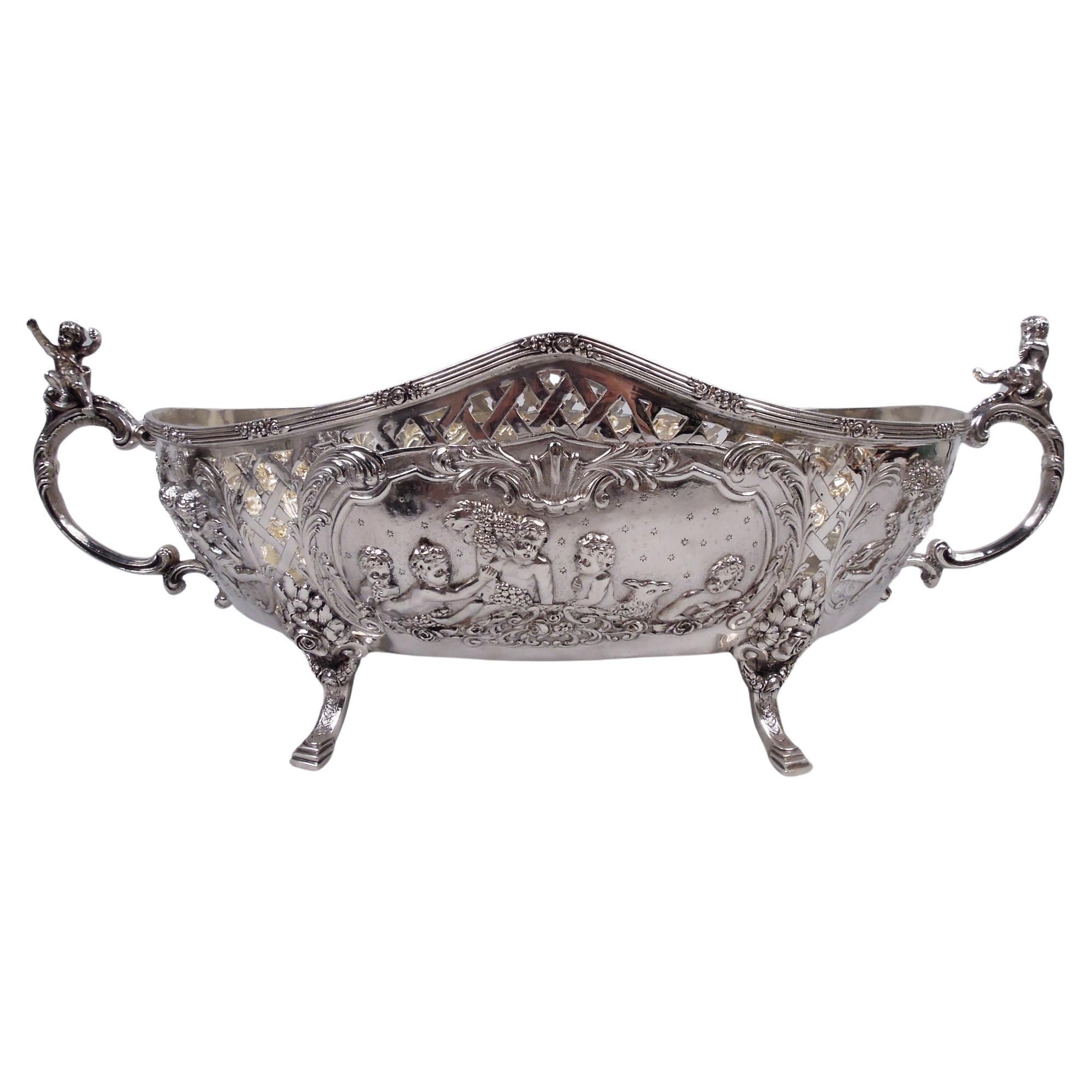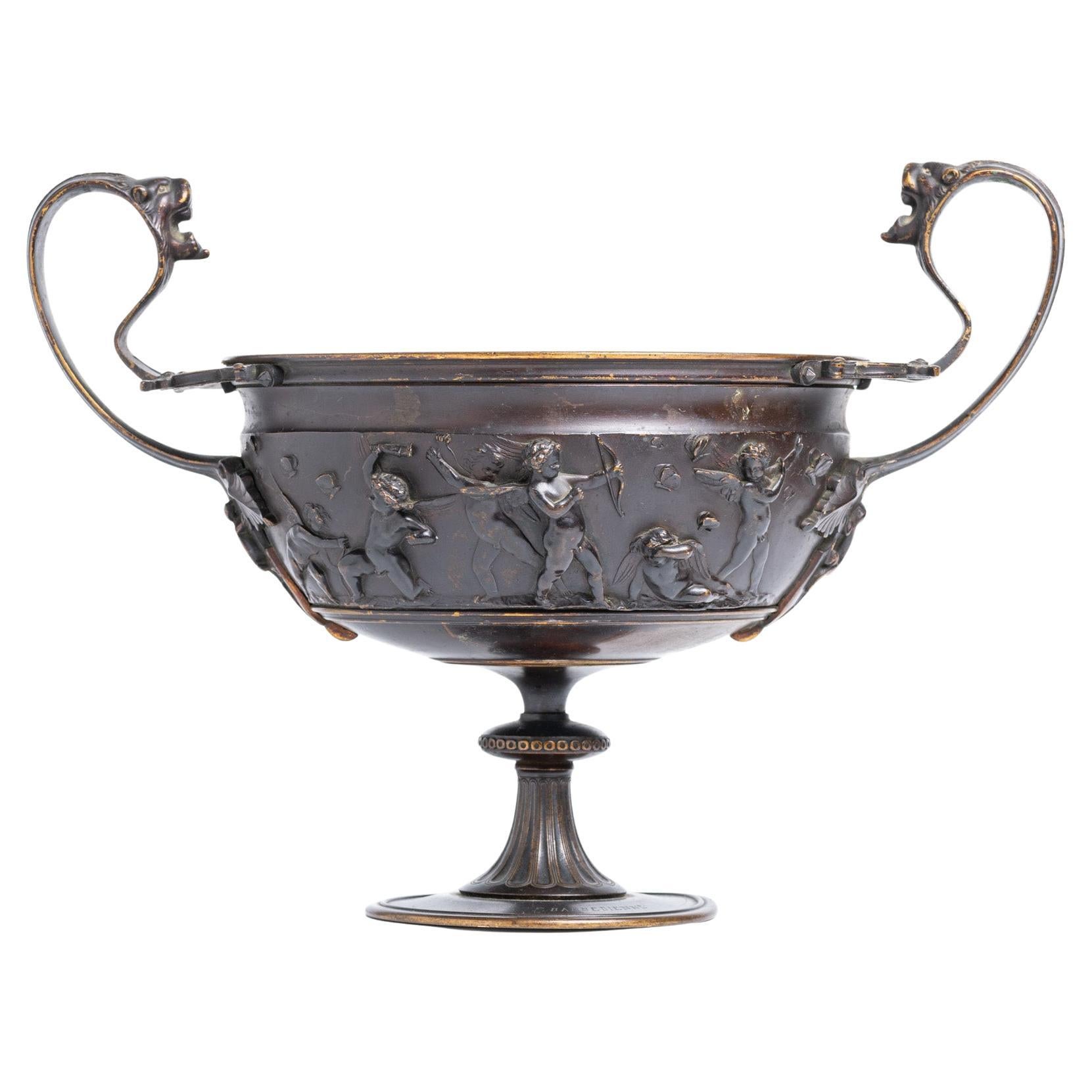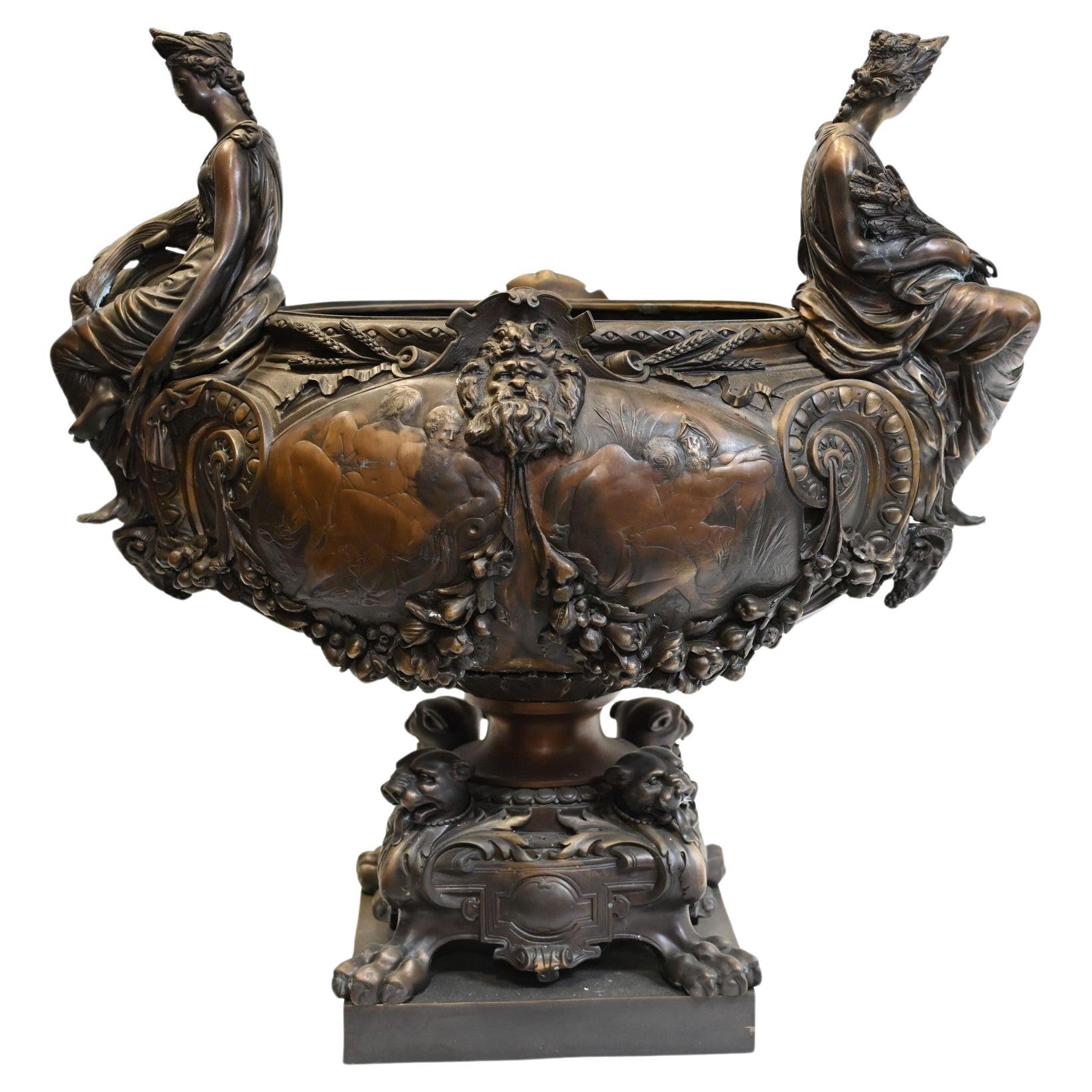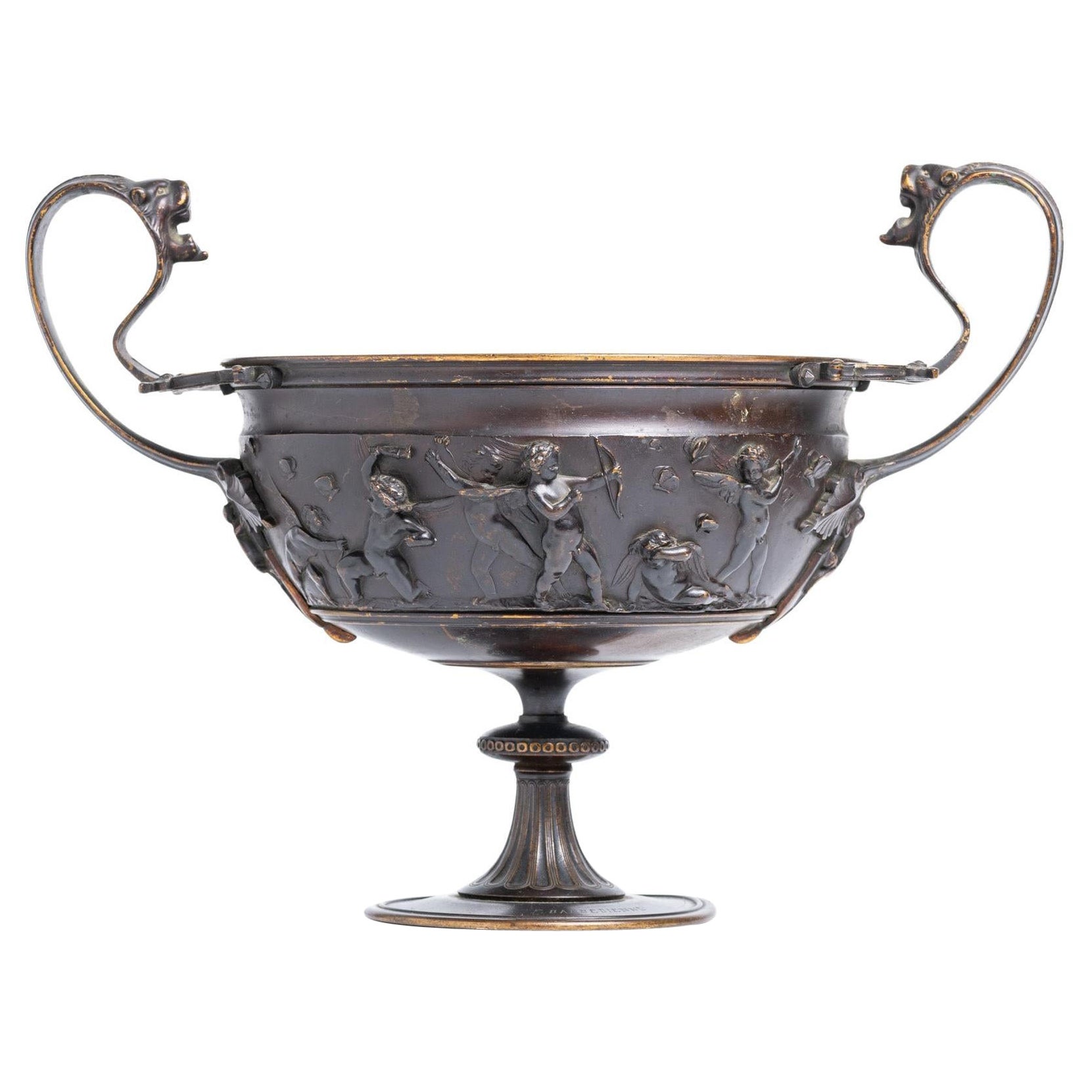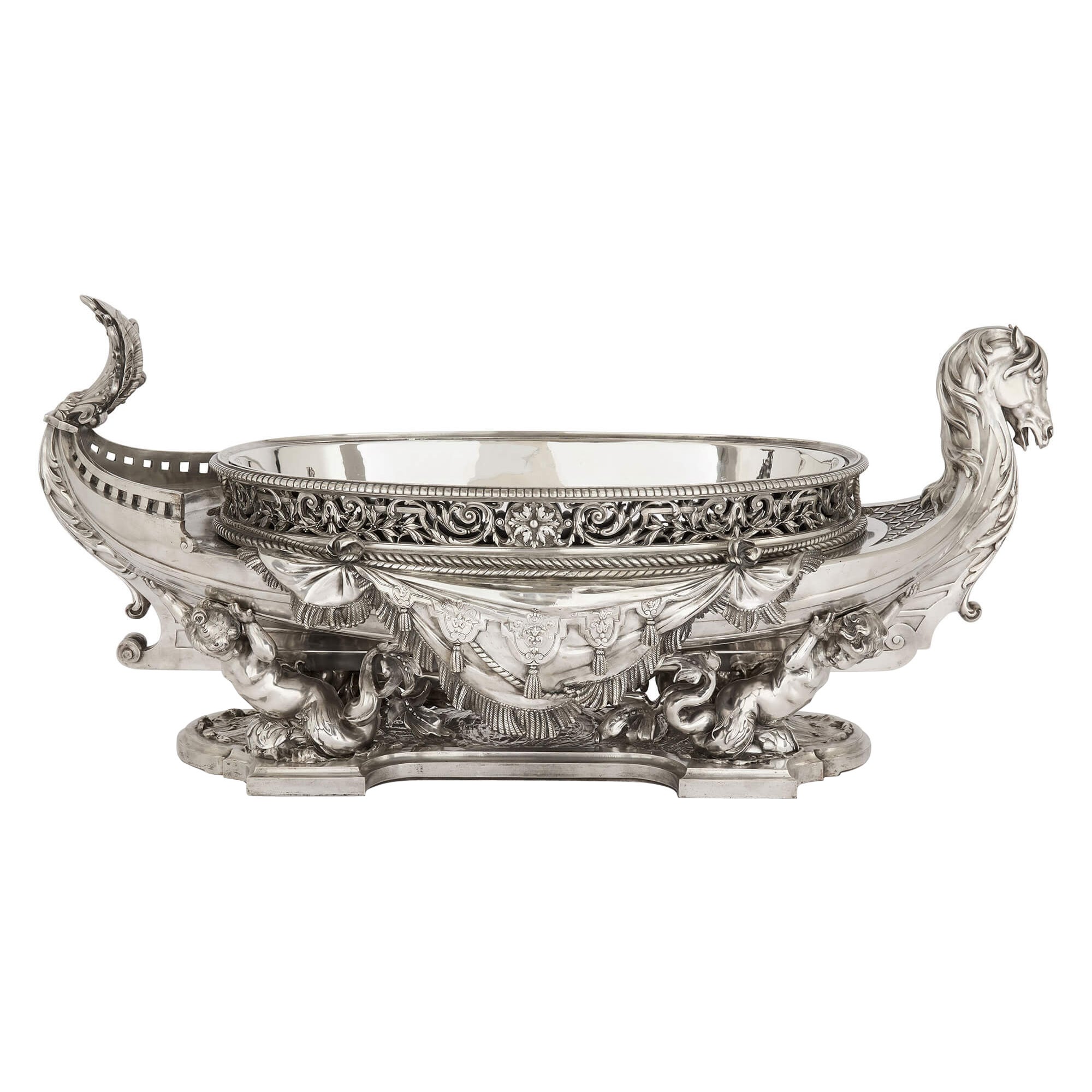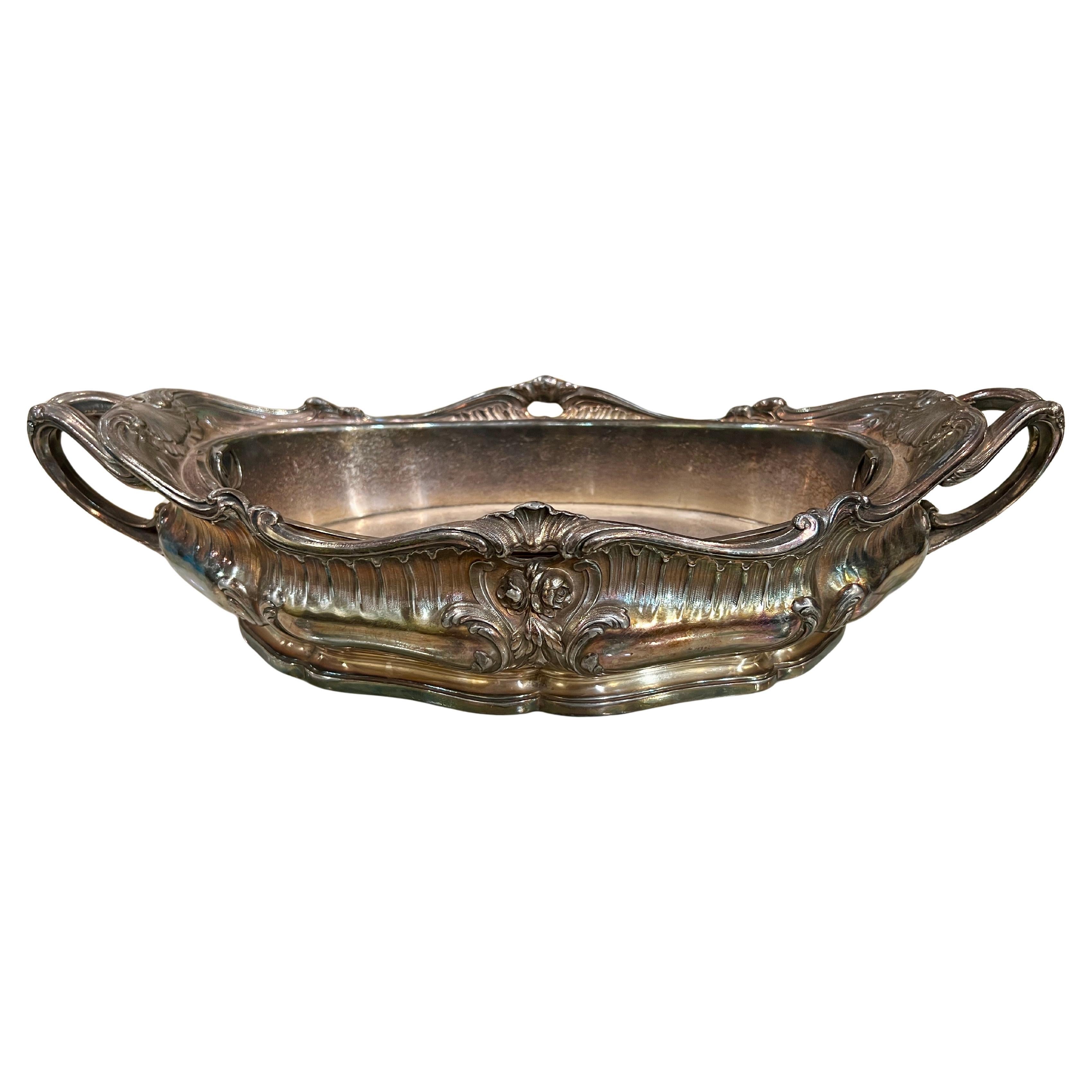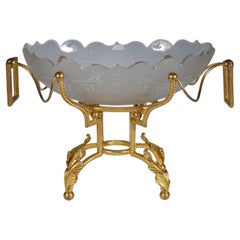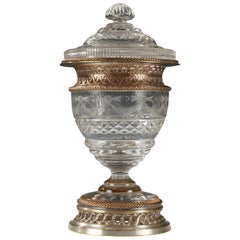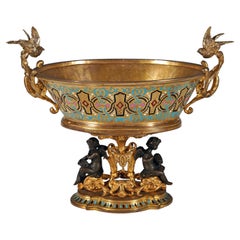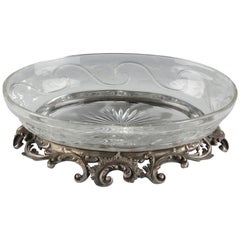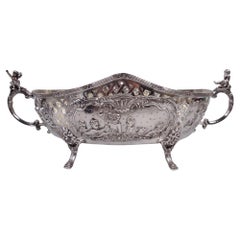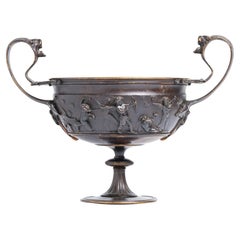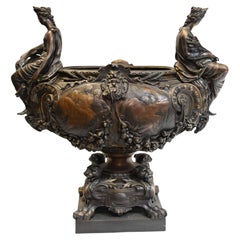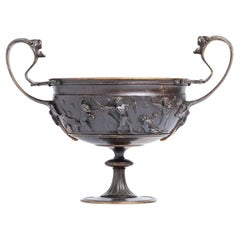Items Similar to Neo-Greek Silvered Bronze Bowl Attributed to G. Servant, France, circa 1880
Want more images or videos?
Request additional images or videos from the seller
1 of 7
Neo-Greek Silvered Bronze Bowl Attributed to G. Servant, France, circa 1880
$5,744.17
£4,266.96
€4,800
CA$7,924.49
A$8,711.19
CHF 4,578.20
MX$105,785.62
NOK 57,111.94
SEK 54,109.55
DKK 36,540.09
About the Item
Beautiful silvered bronze neo-Greek style bowl in a circular shape, adorned on the body with female masks in the antique style and on the sides with handles in the shape of busts of lionesses ending in palmettes. The fluted pedestal is surrounded by a frieze of palmettes. It rests on a Griotte marble molded base with four lions’ paws ending with windings.
Georges Emile Henri Servant (1828-c.1890), who took over his father in 1855 at their foundry, rue Vieille-du-Temple, in Paris, specialized in the production of neo-Egyptian style clocks, very popular in France since 1860’s, and also the making of Greek style decorative objects. He drew considerable attention to the high quality of his bronzes at the 1855 Paris Universal Exhibition and then at the 1862 London Exhibition. At this time Servant exported up to 40% of his production, principally to the United States, where for instance, his clocks were sold with great success by Louis Tiffany Inc. or Hamann & Roche of New York. But his success came really at the 1867 Paris Universal Exhibition, where he was awarded a gold medal for his neo-Greek and Egyptian works (Les Merveilles de l’Exposition Universelle de 1867, t. II, p° 165 & 167). He was even awarded in 1874 the « Ordre national de la Légion d’Honneur », France’s highest official mark of recognition. Servant participated once again successfully at the 1878 Paris Universal Exhibition, where he not only exhibited vases and small bronze pieces of furniture, but was also a member of the jury for the class of bronze pieces of art. He finally retired shortly before the 1889 Paris Universal Exhibition.
- Attributed to:Georges Emile Henri Servant (Maker)
- Dimensions:Height: 10.83 in (27.5 cm)Width: 13.78 in (35 cm)Depth: 11.03 in (28 cm)
- Style:Greek Revival (In the Style Of)
- Materials and Techniques:
- Place of Origin:
- Period:
- Date of Manufacture:circa 1880
- Condition:Wear consistent with age and use.
- Seller Location:PARIS, FR
- Reference Number:Seller: 3581stDibs: LU3860330836622
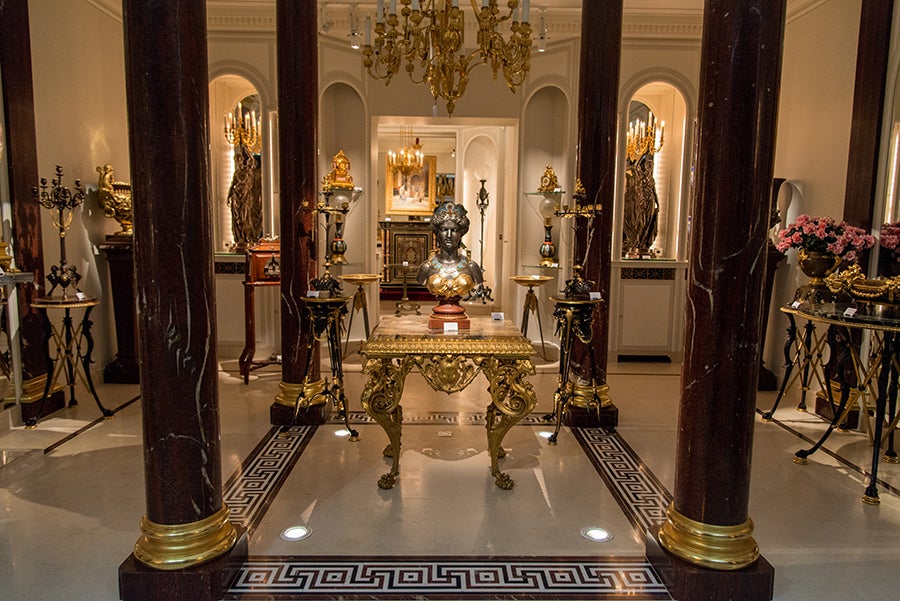
About the Seller
4.9
Vetted Professional Seller
Every seller passes strict standards for authenticity and reliability
Established in 1997
1stDibs seller since 2018
87 sales on 1stDibs
Typical response time: <1 hour
Associations
International Confederation of Art and Antique Dealers' Associations
- ShippingRetrieving quote...Shipping from: PARIS, France
- Return Policy
Authenticity Guarantee
In the unlikely event there’s an issue with an item’s authenticity, contact us within 1 year for a full refund. DetailsMoney-Back Guarantee
If your item is not as described, is damaged in transit, or does not arrive, contact us within 7 days for a full refund. Details24-Hour Cancellation
You have a 24-hour grace period in which to reconsider your purchase, with no questions asked.Vetted Professional Sellers
Our world-class sellers must adhere to strict standards for service and quality, maintaining the integrity of our listings.Price-Match Guarantee
If you find that a seller listed the same item for a lower price elsewhere, we’ll match it.Trusted Global Delivery
Our best-in-class carrier network provides specialized shipping options worldwide, including custom delivery.More From This Seller
View All"Minerva" Crystal Bowl attr. to Baccarat, France, circa 1890
By Cristalleries De Baccarat
Located in PARIS, FR
Charming oval-shaped engraved crystal bowl with scalloped edges and decorated with a Greek frieze centered with a profile portrait of Minerva in a medallion. It rests on a gilded bro...
Category
Antique 1890s French Greek Revival Decorative Bowls
Materials
Crystal, Bronze
Crystal Sugar Bowl, France, Circa 1880
Located in PARIS, FR
Cut and engraved crystal and silvered bronze decor sugar bowl and cover.
Category
Antique 1880s French Decorative Bowls
Materials
Crystal, Bronze
Cup with Cherubs attr. to A. Giroux, France, Circa 1870
By Alphonse Giroux et Cie
Located in PARIS, FR
Charming oval-shaped cup, in gilded bronze and polychrome enamel with arabesque decoration. The leafy handles are surmounted by doves, and it rests on a polylobed base topped with le...
Category
Antique 1870s French Napoleon III Decorative Bowls
Materials
Bronze, Enamel
Lovely Crystal and Silvered Bronze Jardiniere by Cardeilhac, France, Circa 1860
By Cardeilhac
Located in PARIS, FR
Signed Cardeilhac, Paris.
A jardinière consisting of an oval bowl in engraved crystal, decorated with a frieze of foliate waves and a rayed star in the bottom. It fits into a silv...
Category
Antique 1860s French Planters, Cachepots and Jardinières
Materials
Crystal, Bronze
$2,010 Sale Price
52% Off
Neo-Greek Inkwell by C.G. Diehl, E. Frémiet and J. Brandely, France, Circa 1867
By Charles-Guillaume Diehl, Jean Brandely, Emmanuel Fremiet
Located in PARIS, FR
Signed Diehl à Paris.
Wood and silvered copper inkwell. Central drawer ornamented with an escutcheon and flanked by two small lateral drawers forming two containers, surmounted by a lid representing a nestling. Central niche ornamented with a winged creature. Inkwell flanked by two felines. Toped by a penholder representing a Moorish head resting on an eagle claw.
This exceptional piece was realized thanks to the collaboration of ornemanist J. Brandely, sculptor E. Frémiet and cabinet-maker C.-G. Diehl. The motif of the fantasy creature dear to Diehl, is to be seen on the famous cabinet made by him in 1867 and now exhibited at the Metropolitan Museum of Art in New York (Inv. 1989.197).
Arriving in Paris in about 1840 Charles-Guillaume Diehl (1811-1885) founded his cabinet making and decoration firm at 19 rue Michel-le-Comte in 1885. His workshops produced elegant little pieces of furniture in rosewood and thuja and novelties with bronze and porcelain embellishments (see “Les ébénistes du XIXème siècle”, D. Ledoux-Lebard, Ed. de l’amateur, 1982, p.164). It was his luxury boxes, however (liqueur cellarettes, cigar cabinets, games boxes, cashmere cases, jewelry cases) which assured Diehl’s renown (see “l’Art en France sous le Second Empire”, Exposition Grand-Palais, Paris, 1979, p.133). Already rewarded with a bronze medal at the Universal Exhibition of 1855 in Paris, he exhibited a jardinière with china columns and a liqueur cabinet at the Industrial Arts Exhibition in 1861.
In collaboration with the designer Jean Brandely (active from 1867 until 1873), Diehl renovated his decorative repertory and created astonishing pieces of furniture in the Grecian style which had a dazzling success at the Universal Exhibition in Paris in 1867, where his cabinets also won a silver medal. Certain motifs were so typical of Diehl’s work that they received extensive commentary by the art critic J. Mesnard in his book “Les Merveilles de l’Exposition Universal de 1867” (vol. II, pp. 133 & 149). He writes of a table of which “the pendant bearing hooks and the fan shaped radiating motif which ornaments the entablature are engraved with love” (p. 133) and a jewelry case where “The head in fine Grecian style makes up the essential part of the fine gilt bronze ornamentation” (p. 149).
For this Universal Exhibition Diehl also formed a partnership with two famous sculptors: Emile Guillemin (1841-1907) who carved the relief for a mahogany sideboard with galvanic gilt bronzes (Orsay Museum, Paris, Inv. O.A.O. 992) and Emmanuel Frémiet (1824-1910) who executed the low relief for a cedar medal cabinet...
Category
Antique 1860s French Greek Revival Inkwells
Materials
Copper
Charming Silver-Gilt Centerpiece by Boin-Taburet, France, Circa 1880
By Boin-Taburet
Located in PARIS, FR
Elegant centerpiece in finely chiseled vermeil. Composed of a Baccarat cut-crystal cup from which emerge four sinuous light-arms. The whole rests on a scalloped mirrored tray adorned with foliage, with a molded contour of wrapped rushes and ending with four openwork feet.
The two French goldsmiths George Boin and his son-in-law Emile Taburet created circa 1875 in Paris the company Boin-Taburet. They made many silver pieces inspired by the beautiful services of the eighteenth century. At the Paris Universal Exhibition of 1878, Georges Boin presented a “service de toilette” inspired by the work of François-Thomas Germain (1726-1791), and then at the Universal Exhibition of 1889, several epergnes, including one of them executed after drawings by the famous artist Juste-Aurèle Meissonier (1695-1750), as well as tea sets of Louis XIV, Louis XV and Louis XVI styles. Boin-Taburet firm also exhibited a tureen and platter after Pierre Germain...
Category
Antique 1880s French Centerpieces
Materials
Crystal, Vermeil
$16,155 Sale Price / set
27% Off
You May Also Like
Antique German Classical Silver Centerpiece Bowl C 1910
By Hanau
Located in New York, NY
German Classical 800 silver centerpiece, ca 1910. Solid oval well and curved sides with reeded rim, open basketweave, and chased and engraved ornament: Leafing scroll frames inhabite...
Category
Early 20th Century German Neoclassical Revival Decorative Bowls
Materials
Silver
Antique 19th Century French Bronze Bowl By Ferdinand Barbedienne
Located in Portland, England
This exquisite 19th-century French bronze bowl was made by Ferdinand Barbedienne, a well-known French metalworker and manufacturer circa 1870s. The piece is decorated with detailed r...
Category
Antique 1870s French Napoleon III Figurines and Sculptures
Materials
Bronze
Monumental Bronze Bowl Centerpiece French Classical Lerolle Freres
Located in Potters Bar, GB
You are viewing monumental French bronze centerpiece or Jardiniere
Two maiden figurines sit either side of the bowl
At other points it's deco...
Category
Late 20th Century French Provincial Decorative Bowls
Materials
Bronze
Antique 19th Century French Bronze Bowl By Ferdinand Barbedienne
Located in Portland, England
This exquisite 19th-century French bronze bowl was made by Ferdinand Barbedienne, a well-known French metalworker and manufacturer circa 1870s. The piece is decorated with detailed r...
Category
Antique 1870s French Napoleon III Figurines and Sculptures
Materials
Bronze
Very Large French Silvered Bronze Jardinière in the Manner of Christofle
By Christofle
Located in London, GB
Very large French silvered bronze jardinière in the manner of Christofle
French, Late 19th Century
Height 45cm, width 102cm, depth 56cm
This stunning silvered bronze jardinière is...
Category
Antique Late 19th Century French Neoclassical Planters and Jardinieres
Materials
Bronze
Victor Saglier (French, 1809-1894) Silvered Bronze Centerpiece or Planter
By Victor Saglier
Located in Atlanta, GA
This exquisite silvered bronze centerpiece or planter, attributed to renowned French metalworker Victor Saglier, is a testament to 19th-century French decorative art. The centerpiece...
Category
Antique Late 19th Century French Baroque Planters, Cachepots and Jardini...
Materials
Bronze
$1,000 Sale Price
20% Off
More Ways To Browse
Bronze Greek
Antique Greek Revival
Small Bronze Vase
Antique Marble Bowl
Neos Clock
Greek Revival Bedroom
Marble Lion Paw
Seguso Bubble
Venini Murano Bowl
Bitossi Ceramic Bowl
French Wood Bowl
Mid Century Glass Decorative Bowl Oval
Swedish Wooden Bowls
1920s Art Deco Bowls
Bubble Glass Bowls
Hammered Pewter
Vallauris Bowl
Vintage Clam Shell
